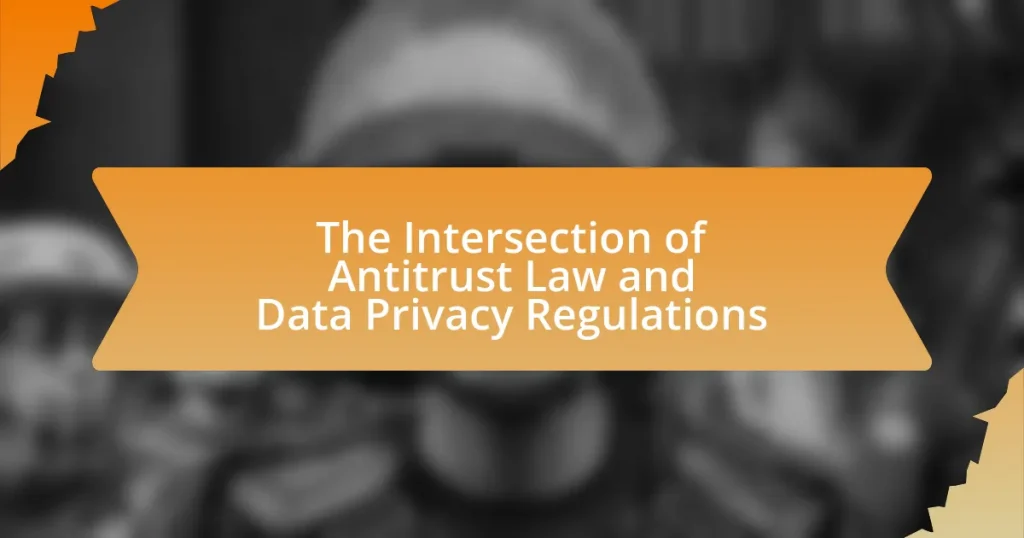Landmark antitrust enforcement actions are significant legal cases initiated by government authorities to combat anti-competitive practices that violate antitrust laws, often involving major corporations. This article examines notable cases from the last decade, including the U.S. Department of Justice’s lawsuits against Microsoft, Google, and Facebook, highlighting their implications for competition law, market structure, and consumer welfare. It discusses the importance of these actions in promoting fair competition, the impact on the economy and consumer choices, and the evolving regulatory landscape shaped by these landmark cases. Additionally, the article outlines key trends in antitrust enforcement, the influence of technology, and best practices for businesses to ensure compliance with antitrust laws.

What are Landmark Antitrust Enforcement Actions?
Landmark antitrust enforcement actions are significant legal cases initiated by government authorities to address anti-competitive practices that violate antitrust laws. These actions often involve major corporations and can lead to substantial penalties, changes in business practices, or even the breakup of companies. For example, the U.S. Department of Justice’s lawsuit against Microsoft in the late 1990s aimed to curb monopolistic behavior in the software market, resulting in a settlement that imposed restrictions on Microsoft’s business operations. Such cases serve as critical precedents in shaping antitrust policy and enforcement in the United States and globally.
Why are antitrust enforcement actions important?
Antitrust enforcement actions are important because they promote competition and prevent monopolistic practices that can harm consumers and the economy. By regulating anti-competitive behavior, such as price-fixing and market manipulation, these actions ensure fair pricing, innovation, and consumer choice. Historical examples, such as the U.S. v. Microsoft case in the late 1990s, demonstrate that effective antitrust enforcement can lead to increased competition in the software market, ultimately benefiting consumers through lower prices and improved products.
What impact do these actions have on the economy?
Antitrust enforcement actions significantly impact the economy by promoting competition and preventing monopolistic practices. These actions can lead to lower prices for consumers, increased innovation, and improved product quality as companies strive to differentiate themselves in a competitive market. For instance, the U.S. Department of Justice’s lawsuit against Microsoft in the late 1990s resulted in a more competitive software market, which benefited consumers through better products and pricing. Additionally, the Federal Trade Commission’s actions against large tech companies in recent years aim to curb anti-competitive behavior, fostering a healthier economic environment that encourages new entrants and supports small businesses.
How do they affect consumer choices?
Antitrust enforcement actions significantly affect consumer choices by promoting competition and preventing monopolistic practices. When regulatory bodies take action against companies that engage in anti-competitive behavior, they help ensure that consumers have access to a wider variety of products and services at fair prices. For instance, the U.S. Department of Justice’s lawsuit against Google in 2020 aimed to address concerns over its dominance in online search and advertising, which could limit consumer options and inflate prices. By fostering a competitive marketplace, antitrust actions empower consumers to make informed choices, ultimately enhancing their welfare and satisfaction.
What criteria define a landmark antitrust case?
A landmark antitrust case is defined by its significant impact on competition law, market structure, and consumer welfare. Such cases typically involve major corporations and address practices like monopolistic behavior, price-fixing, or anti-competitive mergers. For instance, the United States v. Microsoft Corp. case in the late 1990s exemplified a landmark case as it challenged Microsoft’s monopolistic practices in the software market, leading to substantial changes in how technology companies operate. The outcomes of these cases often set legal precedents, influence regulatory policies, and shape the enforcement of antitrust laws, thereby demonstrating their importance in maintaining fair competition.
What legal precedents are set by these cases?
The legal precedents set by landmark antitrust enforcement actions of the last decade include the establishment of stricter standards for evaluating anti-competitive behavior, particularly in digital markets. These cases have clarified the application of the Sherman Act and the Clayton Act, emphasizing the importance of consumer welfare and market competition. For instance, the Federal Trade Commission’s actions against major tech companies have reinforced the notion that monopolistic practices can be challenged even if they do not result in immediate price increases, thereby expanding the scope of antitrust scrutiny. Additionally, these cases have highlighted the necessity for regulatory bodies to adapt to evolving market dynamics, particularly in technology, where traditional metrics of competition may not apply.
How do these cases influence future antitrust policies?
Landmark antitrust cases shape future policies by establishing legal precedents and influencing regulatory frameworks. For instance, the 2020 U.S. antitrust case against Google set a significant benchmark for evaluating monopolistic practices in the digital marketplace, prompting regulators to scrutinize similar tech giants more rigorously. Additionally, the outcomes of these cases often lead to legislative changes, as seen with the increased calls for reform in antitrust laws following high-profile actions against companies like Facebook and Amazon. These cases highlight the need for adaptive policies that address evolving market dynamics and consumer protection, thereby guiding future enforcement strategies and legislative initiatives.
What are the key trends in antitrust enforcement over the last decade?
Key trends in antitrust enforcement over the last decade include increased scrutiny of big tech companies, a shift towards more aggressive enforcement actions, and a growing emphasis on consumer welfare and market competition. Regulatory bodies, particularly in the United States and Europe, have intensified investigations into monopolistic practices, with notable cases against companies like Google, Facebook, and Amazon. For instance, the Federal Trade Commission and the Department of Justice have pursued multiple high-profile lawsuits aimed at curbing anti-competitive behavior, reflecting a broader commitment to maintaining market fairness. Additionally, there has been a rise in bipartisan support for reforming antitrust laws to address modern market dynamics, indicating a significant evolution in the approach to antitrust enforcement.
How has technology influenced antitrust actions?
Technology has significantly influenced antitrust actions by enabling regulators to better analyze market dynamics and consumer behavior. The rise of digital platforms has led to increased scrutiny of monopolistic practices, as seen in cases against major tech companies like Google and Facebook. For instance, the U.S. Department of Justice’s lawsuit against Google in 2020 highlighted concerns over its dominance in online search and advertising, illustrating how technology facilitates the collection of data that can reveal anti-competitive behavior. Additionally, advancements in data analytics allow regulators to assess market power and consumer harm more effectively, leading to more informed and targeted enforcement actions.
What role do international markets play in these cases?
International markets serve a critical role in landmark antitrust enforcement actions by influencing competitive dynamics and regulatory scrutiny across borders. These markets often expose companies to varying legal standards and competitive pressures, prompting regulators to assess the global implications of anti-competitive behavior. For instance, the European Union’s antitrust actions against major tech firms, such as Google, highlight how international market presence can lead to significant fines and operational changes, as seen in the €2.42 billion fine imposed in 2017 for unfair competition practices. This demonstrates that international markets not only shape the enforcement landscape but also compel companies to adapt their strategies to comply with diverse regulatory frameworks.

What are some notable antitrust enforcement actions from the last decade?
Notable antitrust enforcement actions from the last decade include the U.S. Department of Justice’s lawsuit against AT&T’s acquisition of Time Warner in 2017, which was ultimately unsuccessful, and the European Commission’s fine of Google €4.34 billion in 2018 for antitrust violations related to its Android operating system. Additionally, the Federal Trade Commission filed a lawsuit against Facebook in 2020, alleging anti-competitive practices, and the European Commission imposed a €1.49 billion fine on Google in 2019 for abuse of market dominance in online advertising. These actions reflect significant regulatory scrutiny aimed at maintaining competitive markets.
How did the United States v. Microsoft case shape antitrust law?
The United States v. Microsoft case significantly shaped antitrust law by establishing a precedent for how courts evaluate monopolistic practices in the technology sector. The case, initiated in 1998, focused on Microsoft’s dominance in the PC operating system market and its practices that allegedly stifled competition, such as bundling its Internet Explorer browser with Windows. The court’s findings led to a more rigorous scrutiny of anti-competitive behavior, emphasizing the importance of consumer welfare and market competition. This case also prompted legislative discussions on the need for updated antitrust frameworks to address the unique challenges posed by rapidly evolving technology markets, influencing subsequent antitrust actions and policies.
What were the main allegations against Microsoft?
The main allegations against Microsoft included anti-competitive practices, specifically the bundling of its Internet Explorer web browser with the Windows operating system to stifle competition. This behavior was seen as an attempt to maintain its monopoly in the operating system market and limit the market share of rival browsers. Additionally, Microsoft faced accusations of using its dominant position to impose restrictive licensing agreements on computer manufacturers and software developers, which further hindered competition. These allegations were central to the U.S. Department of Justice’s antitrust case against Microsoft in the late 1990s and early 2000s, ultimately leading to a settlement that imposed various restrictions on the company’s business practices.
What was the outcome and its implications?
The outcome of landmark antitrust enforcement actions in the last decade has led to significant changes in market dynamics and regulatory practices. These actions, such as the U.S. Department of Justice’s lawsuit against Google in 2020, aimed to address monopolistic behaviors and promote competition. The implications include increased scrutiny of large tech companies, potential restructuring of business practices, and a shift towards more stringent regulatory frameworks to prevent anti-competitive behavior. This trend reflects a growing recognition of the need to balance innovation with fair market competition, as evidenced by the rising number of antitrust investigations and lawsuits initiated by various governments worldwide.
What lessons can be learned from the Google antitrust case?
The Google antitrust case teaches the importance of regulatory scrutiny in maintaining competitive markets. It highlights how dominant firms can engage in practices that stifle competition, such as preferential treatment of their own services over rivals. For instance, the U.S. Department of Justice filed a lawsuit in 2020 alleging that Google used its market power to suppress competition in online advertising and search, which illustrates the need for vigilance against anti-competitive behavior. This case underscores the necessity for clear antitrust laws that adapt to the digital economy, ensuring that innovation and consumer choice are preserved.
What specific practices were challenged in this case?
The specific practices challenged in this case include anti-competitive behavior such as price-fixing, market allocation, and exclusive dealing arrangements. These practices were scrutinized for their potential to harm competition and consumer welfare, as evidenced by legal actions taken against companies involved in such conduct. For instance, the enforcement actions aimed to dismantle agreements that restricted market access for competitors, thereby ensuring a fairer marketplace.
How did the case affect the tech industry?
The case significantly impacted the tech industry by increasing regulatory scrutiny and prompting major companies to reassess their business practices. Following the enforcement actions, tech giants faced heightened pressure to ensure compliance with antitrust laws, leading to changes in how they operate, particularly in areas like data privacy and market competition. For instance, the Federal Trade Commission’s actions against major firms resulted in a wave of self-regulation and policy adjustments aimed at avoiding further legal challenges, thereby reshaping the competitive landscape within the industry.
What was the significance of the Facebook antitrust lawsuit?
The significance of the Facebook antitrust lawsuit lies in its potential to reshape the landscape of digital competition and privacy regulations. Filed by the Federal Trade Commission in December 2020, the lawsuit accused Facebook of anti-competitive practices, particularly its acquisitions of Instagram and WhatsApp, which the FTC argued stifled competition. This case represents a critical moment in antitrust enforcement, as it challenges the dominance of major tech companies and seeks to establish clearer guidelines for market competition in the digital age. The outcome could set precedents for future regulatory actions against monopolistic behaviors in the technology sector, influencing how companies operate and compete.
What were the main arguments presented by the plaintiffs?
The main arguments presented by the plaintiffs in landmark antitrust enforcement actions typically include claims of anti-competitive practices, such as monopolization, price-fixing, and unfair market dominance. For instance, in the case against a major technology company, plaintiffs argued that the company’s practices stifled competition by creating barriers for new entrants and manipulating market conditions to maintain its dominance. These arguments are often supported by evidence of market share data, consumer harm, and economic analyses demonstrating the negative impact of the defendant’s actions on competition and innovation.
What potential outcomes could arise from this case?
Potential outcomes from this case include significant changes in market competition, potential penalties for the involved parties, and the establishment of legal precedents. For instance, if the case results in a ruling against a major corporation for antitrust violations, it could lead to increased scrutiny of similar companies, fostering a more competitive environment. Historical examples, such as the 2018 case against Qualcomm, resulted in substantial fines and operational changes, demonstrating how antitrust enforcement can reshape industry practices. Additionally, the case may influence future legislation or regulatory approaches to antitrust issues, as seen in the evolving legal landscape following landmark cases over the past decade.

How do these landmark cases influence future antitrust enforcement?
Landmark antitrust cases shape future enforcement by establishing legal precedents and clarifying regulatory standards. For instance, the United States v. Microsoft Corp. case in the late 1990s set a significant precedent regarding monopolistic practices and the definition of market dominance, influencing how regulators assess competitive behavior in technology markets. Similarly, the Federal Trade Commission’s actions against Facebook in 2020 highlighted the scrutiny of mergers and acquisitions in the digital space, signaling a more aggressive stance on anti-competitive practices. These cases inform future regulatory approaches by providing frameworks for evaluating market power, consumer harm, and the necessity of maintaining competitive markets.
What changes in legislation have resulted from these cases?
Recent landmark antitrust enforcement actions have led to significant changes in legislation, particularly in the areas of digital market regulation and monopolistic practices. For instance, the European Union’s Digital Markets Act, enacted in 2022, aims to ensure fair competition in digital markets by imposing stricter rules on large tech companies, addressing issues such as data privacy and anti-competitive behavior. Additionally, the U.S. has seen proposals for updating antitrust laws, including the introduction of the American Innovation and Choice Online Act, which seeks to prevent dominant platforms from favoring their own products over competitors. These legislative changes are a direct response to the findings and implications of recent antitrust cases, reflecting a growing recognition of the need for regulatory frameworks that can effectively manage the complexities of modern digital economies.
How have enforcement agencies adapted their strategies?
Enforcement agencies have adapted their strategies by increasing collaboration with international counterparts and leveraging advanced technology for data analysis. This shift is evident in the U.S. Department of Justice and the Federal Trade Commission, which have enhanced their focus on digital markets and monopolistic practices, responding to the rise of tech giants. For instance, the agencies have utilized economic modeling and algorithmic analysis to assess market dynamics more effectively, as seen in cases against companies like Google and Facebook. These adaptations reflect a proactive approach to address evolving market challenges and ensure competitive practices in the digital economy.
What new challenges are emerging in antitrust enforcement?
New challenges in antitrust enforcement include the rise of digital monopolies and the complexities of regulating technology platforms. As companies like Google and Amazon dominate their respective markets, traditional antitrust frameworks struggle to address issues such as data privacy, market manipulation, and the rapid pace of innovation. For instance, the European Union’s Digital Markets Act aims to tackle these challenges by imposing stricter regulations on large tech firms, highlighting the need for updated legal frameworks to effectively manage the unique characteristics of digital markets.
What best practices can businesses adopt to avoid antitrust issues?
Businesses can adopt several best practices to avoid antitrust issues, including maintaining transparent pricing strategies, avoiding collusion with competitors, and ensuring compliance with antitrust laws. Transparent pricing strategies help prevent price-fixing allegations, while avoiding collusion ensures that businesses do not engage in anti-competitive agreements that could lead to legal scrutiny. Compliance with antitrust laws, such as the Sherman Act and the Clayton Act, is crucial; companies should regularly train employees on these regulations and conduct internal audits to identify potential risks. Historical cases, such as the 2018 AT&T and Time Warner merger, highlight the importance of these practices, as the merger faced significant scrutiny over potential anti-competitive effects, ultimately leading to a court ruling that emphasized the need for compliance with antitrust regulations.
How can companies ensure compliance with antitrust laws?
Companies can ensure compliance with antitrust laws by implementing robust compliance programs that include regular training, monitoring, and legal audits. These programs should educate employees about antitrust regulations, establish clear reporting mechanisms for potential violations, and conduct periodic assessments to identify and mitigate risks. For instance, the Federal Trade Commission emphasizes the importance of proactive compliance measures, which can prevent costly legal disputes and fines, as seen in cases like the 2018 AT&T-Time Warner merger, where compliance efforts were scrutinized.
What role does corporate governance play in preventing violations?
Corporate governance plays a critical role in preventing violations by establishing frameworks that promote accountability, transparency, and ethical behavior within organizations. Effective corporate governance mechanisms, such as board oversight, compliance programs, and internal controls, help to identify and mitigate risks associated with unethical practices and regulatory non-compliance. For instance, the implementation of robust compliance programs has been shown to reduce instances of antitrust violations, as evidenced by the increased scrutiny and enforcement actions taken against companies that lack adequate governance structures. This correlation highlights the importance of corporate governance in fostering a culture of integrity and compliance, ultimately deterring potential violations.



